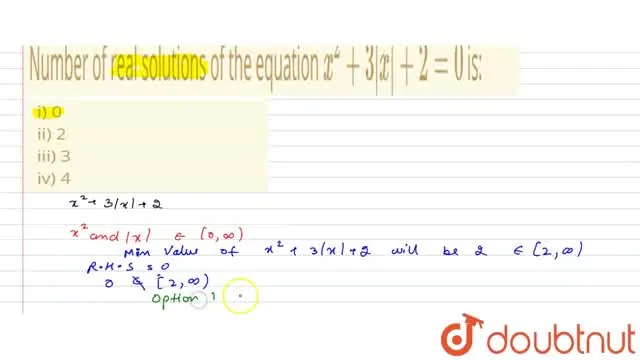Number of real solutions of the equation x2+3|x|+2=0 is:
i) 0
ii) 2
iii) 3
iv) 4
0
2
3
4
The correct Answer is:A
Step by step video & image solution for Number of real solutions of the equation x ^(2) +3|x| + 2 =0 is: i) 0 ii) 2 iii) 3 iv) 4 by Maths experts to help you in doubts & scoring excellent marks in Class 12 exams.
Related Playlists
- BOOK - VIKAS GUPTA (BLACK BOOK) ENGLISHCHAPTER - QUADRATIC EQUATIONS EXERCISE - EXERCISE (ONE OR MORE THAN ONE ANSWER IS/ARE CORRECT)42videos
QUADRATIC EQUATIONS
- BOOK - VIKAS GUPTA (BLACK BOOK) ENGLISHCHAPTER - QUADRATIC EQUATIONS EXERCISE - EXERCISE (COMPREHENSION TYPE PROBLEMS)23videos
QUADRATIC EQUATIONS
- BOOK - VIKAS GUPTA (BLACK BOOK) ENGLISHCHAPTER - PROBABILITY EXERCISE - Exercise -5 : Subjective Type problems11videos
PROBABILITY
- BOOK - VIKAS GUPTA (BLACK BOOK) ENGLISHCHAPTER - SEQUENCE AND SERIES EXERCISE - EXERCISE (SUBJECTIVE TYPE PROBLEMS)21videos
SEQUENCE AND SERIES
Similar Questions
If S is the set of all real x such that 2x−12x3+3x2+x is (−∞,−32) b. (−32,14) c. (−14,12) d. (12,3) e. None of these
03:02View SolutionLet f(x)=ax2+bx+c,a≠0, such the f(−1−x)=f(−1+x)∀x∈R. Also given that f(x)=0 has no real roots and 4a+b>0.
Let α=4a−2b+c,β=9a+3b+c,γ=9a−3b+c, then which of the following is correct ?02:04View SolutionMr. A writes an article. The article originally is error free. Each day Mr. B introduces one new error into the article. At the end of the day, Mr. A checks the article and has 23 chance of catching each individual error still in the article. After 3 days, the probability that the article is error free can be expressed as pq where p and q are relatively prime positive integers. Let λ=q−p, then find the sum of the digits of λ.
02:26View SolutionLet a,b,c,d be four distinct real number in A.P.Then the smallest positive vlaue of k satisfying 2(a−b)+k(b−c)2+(c−a)3=2(a−d)+(b−d)2+(c−d)3is_________
01:50View SolutionWhich of the following symbols are not acceptable ? (i) ._(35)^(79)Br (ii) .^(79)Br (iii) ._(79)^(35)Br (iv) ._(35)Br
02:10View SolutionThe value of |[a,a+d,a+2d] , [a+d,a+2d,a+3d] , [a+2d,a+3d,a+4d]|+|[b
View SolutionArrange the following compounds in the decreasing order of the boiling point:
CH3BrI CH3CH2BrII CH3CH2CH2BrIII
CH3CH2CH2CH2BrView SolutionChoose the chain terminating step
(1) H2→H⋅+H⋅
(2) Br2→Br⋅+Br⋅
(3) Br⋅+HBr→H⋅+Br2
(4) H⋅+Br2→HBr+Br⋅
(5) Br⋅+Br⋅→Br2View SolutionIn CH_(3)CH_(2)Br,% of Br is
View SolutionPredict all order of reactivity of the following compounds in dehydrohalogenation. a,. I. CH_(3)CH_(2)CH_(2)CH_(2)Cl II. (CH_(3))_(2)CHCH_(2)Cl III. (CH_(3))_(2)CH - CH_(2)Br IV. CH_(3)CH(Br)CH_(2)CH_(3) V. (CH_(3))_(3) C - Br b. I. CH_(3)CH(Br)CH_(3) II. CH_(3)CH_(2)CH_(2)Br III. (CH_(3))_(2) CH - CH_(2) Br IV. (CH_(3))_(3)C - CH_(2) Br
01:21View SolutionArrange the following in increasing order of the property indicated.
(i) F, Cl, Br and I (negative electron gain enthalpy)
(ii) Mg2+,O2−,Na+,F−andN3− (ionic size)
(iii) Mg, Al, Si and Na (ionization enthalpy)
(iv) Br+BrandBr− (size)02:07View SolutionArrange the following in increasing order of the property indicated.
(i) F, Cl, Br and I (negative electron gain enthalpy)
(ii) Mg2+,O2−,Na+,F−andN3− (ionic size)
(iii) Mg, Al, Si and Na (ionization enthalpy)
(iv) Br+BrandBr− (size)01:15View SolutionArrange the following compounds in increasing order of acidity.
(i) CH3CH(Br)CH2COOH
(ii) CH3CH2CH(Br)COOH
(iii) CH3CH2C(Br)2COOH
(iv) CH2BrCH2CH2COOH02:06View Solutionఏ అవయవాలు కవాటాలు కల్గి ఉంటాయి ?br i) గుండెbr ii) ధమనిbr iii) సిరలుbr iV) శోషరస నాళాలు
02:00View Solution1) Fragmentation () a) Planaria br 2) Unripe fruits () b) Yeast br 3) Desire () c) Spirogyra br 4) Reproduction () d) Watermelon br
01:51View Solutionవేర్ల ద్వారా శాఖీయోత్పత్తి జరిపే మొక్కbr i) డాలియాbr ii) ముల్లంగిbr iii) క్యారెట్br iv) క్యాబేజిbr
01:38View Solution


